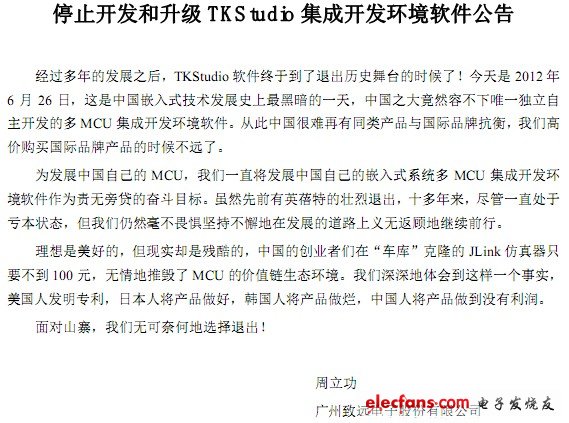In the highly competitive tool software market, TKStudio IDE developed by Guangzhou Zhiyuan Electronics Co., Ltd. (Zhou Ligong MCU) is unique and has been working quietly for more than ten years. However, Zhou Ligong announced on Weibo that he has abandoned the TKS embedded integrated development environment for many years, which has caused concern in many industry.
"After years of development, TKS integrated development environment software has finally come out of the historical stage, today is June 26, 2012, this is the darkest day in the history of China's embedded technology development, China's big can not tolerate the only independent Developed multiple MCU integrated development environment software. From then on, it is difficult for similar products to compete with international brands, and one day will pay the price of blood." Zhou Ligong said in his Weibo.

He said, "The ideal is beautiful, but the reality is cruel. The JLink simulator that Chinese entrepreneurs cloned in the 'garage' is less than 100 yuan, relentlessly destroying the value chain ecosystem of the MCU. I am deep. I deeply realized that the Americans invented patents, the Japanese made the products well, the Koreans made the products bad, and the Chinese made the products at a loss. In the face of the cottage, we have no choice but to quit!"
Seeing a bleak feeling here, this is the only domestic and powerful domestic embedded integrated development environment that has come to an end. We found the corresponding announcement on the official website of Guangzhou Zhiyuan Electronics Co., Ltd.

Guangzhou Departure Announcement issued by Zhiyuan Electronics Co., Ltd.
After Zhou Ligong's Weibo was released, it caused a heated discussion among netizens. Some people suggested that open source should be handed over to the community for maintenance. Some people said that they were willing to represent the sales of the software, and some people advised them to stick to it... Zhou Ligong responded one by one. He introduced that TKS is sold with the emulator, and there is no charge for simply using the software. Only the current emulator market is extremely chaotic, broken. The JLink emulator is also sold for about 100 yuan on Taobao, and TKS basically needs to sell for about 2,000 yuan. Compared with the two, most users are willing to buy the broken version of JLink, and now the user loss is serious. The sales of all ARM emulators in the industry are far less than the 8051 era. Although there were a lot of competitions at that time, there was no break, and everyone could survive. It is difficult to survive even now. He said that enterprises must only give up their TKS.
Regarding the open source proposal put forward by netizens, Zhou Zong responded, "Disappointed, open source is also boring. If we don't do it, we will not open it, otherwise we will have to spend energy on maintenance. In order to give employees a better future, we must Strong men break their arms, cut off products that don't make money and don't make much money, and lack core competitiveness in the future, and concentrate on doing a limited number of products."
USB3.0 - also considered SuperSpeed USB - for those with PC or audio / high-frequency device to provide a variety of devices connected to a standard interface. From the keyboard to high-throughput disk drive, a variety of devices can use this low-cost interface for smooth operation of the plug and play connectivity, users basically do not spend too much thought in it. The new USB 3.0 to maintain compatibility with USB 2.0 also provides several enhancements to the following:
Greatly increased bandwidth - up to 5Gbps full duplex (USB2.0 was 480Mpbs duplex) to achieve better power management enables the host to provide more power for the device to achieve USB-rechargeable battery, LED lighting And mini-fan applications. Enable faster identification of the host device the new agreement makes data processing more efficient USB 3.0 storage device can be limited by the rate of transferring large amounts of stored files (such as HD movies).
For example, a use of USB 3.0 flash drive in the 3.3 seconds to transfer 1GB of data to a host, and USB 2.0 requires 33 seconds. Consumer electronics devices by increasing the resolution and storage performance requirements driven by the hope that through a broadband Internet connection to achieve wider media applications, so users need faster transmission performance, to simplify the downloading, storage, and a large number of multimedia Content sharing. USB 3.0 to provide consumers with easy connectivity it needs played a crucial role. When the device when used in consumer, USB 3.0 will address not recognize USB2.0 devices without battery problems. Host to reduce the current through the USB 3.0 slow to recognize these devices, such as mobile phone battery has gone bad.
For the purposes of systems and ASIC developers, USB 3.0 chips and IP to ensure a wide range of practical requirements of each design can be met in a timely manner. The full range of support for standards such as USB 3.0 is particularly important because the speed, advanced protocol and a variety of cable length (from a few inches to several meters) makes the design and standards compliance as a challenge.
USB 3.0 Flash Drive,Type-C USB Stick,3.0 USB Flash Drive,3.0 Pen Drive
Custom Usb Gift company limited , https://www.customusbgift.com